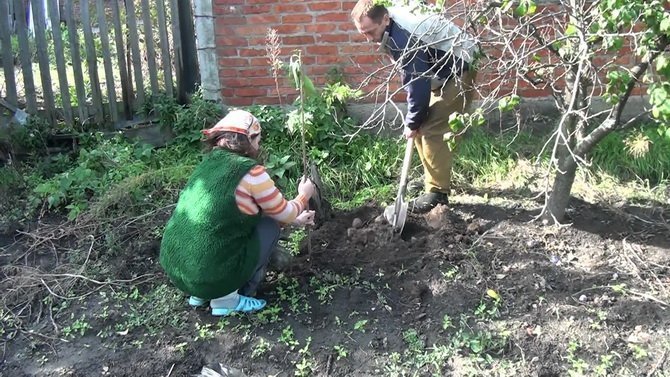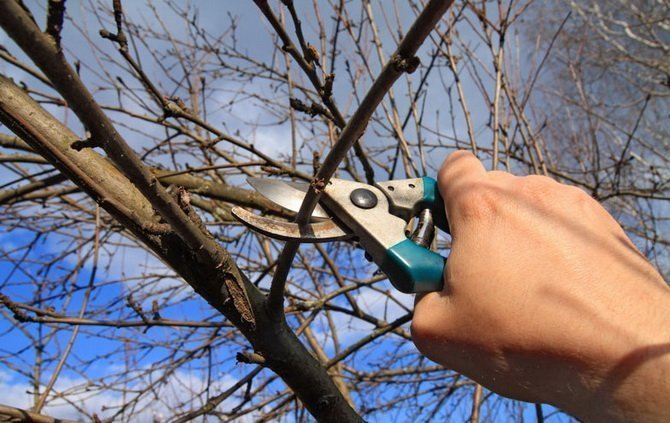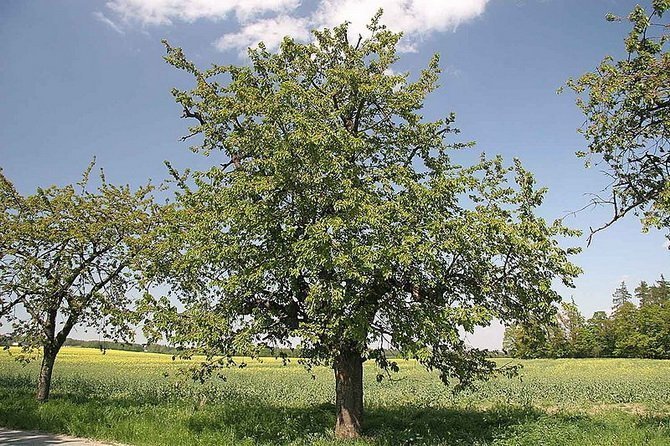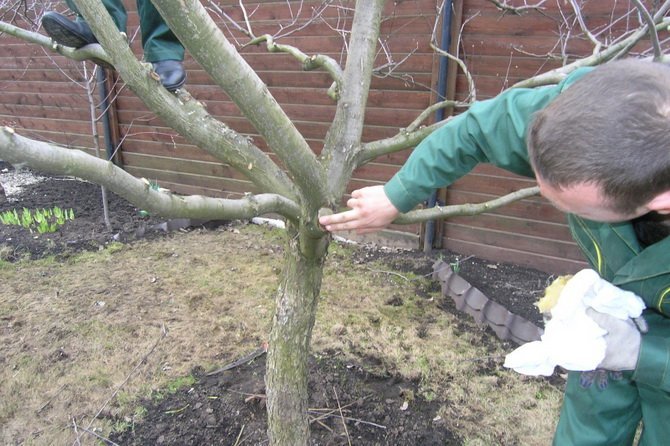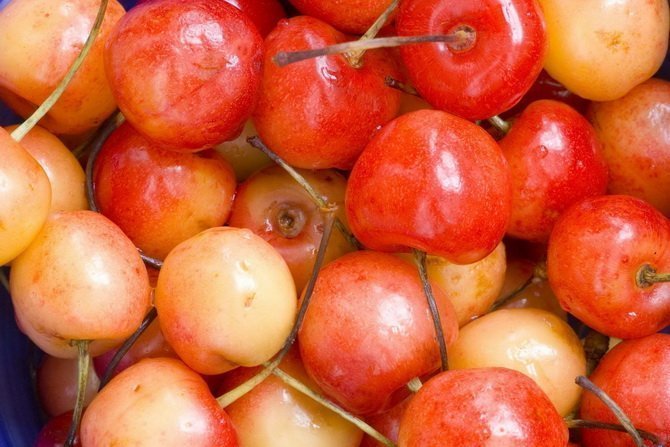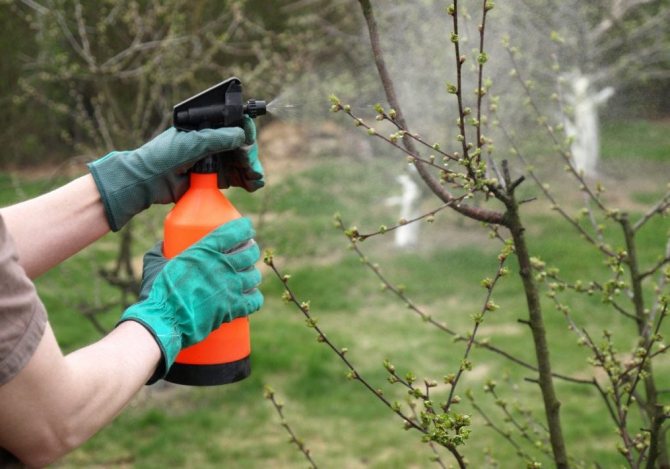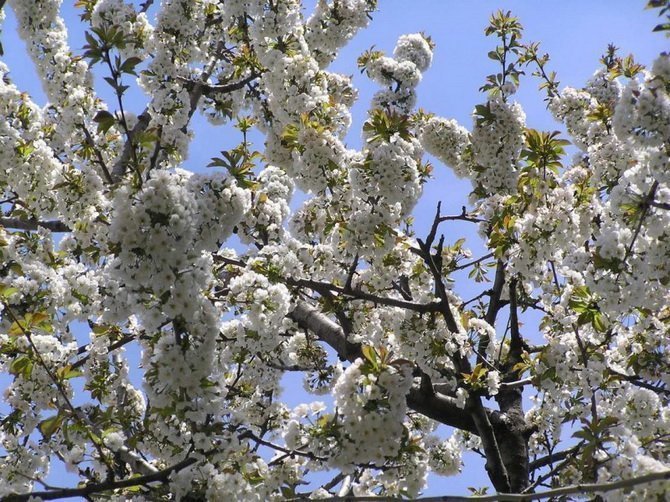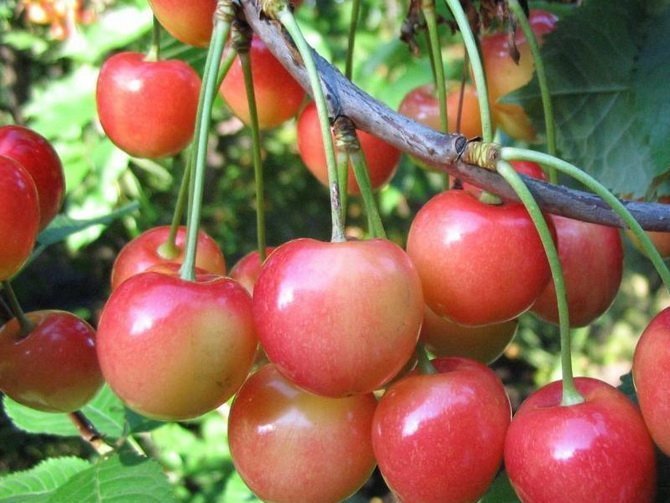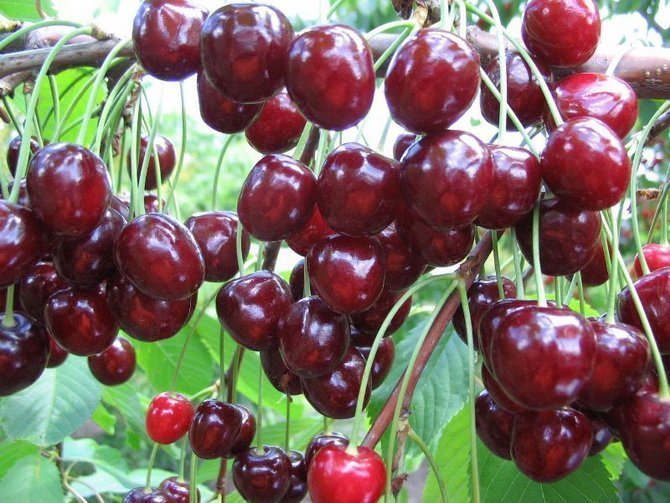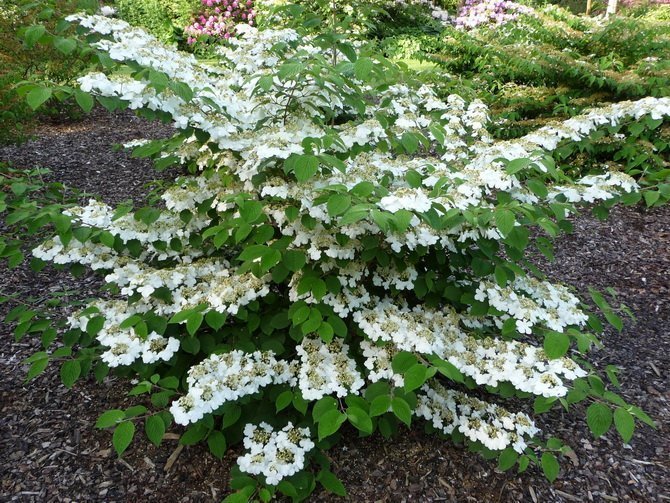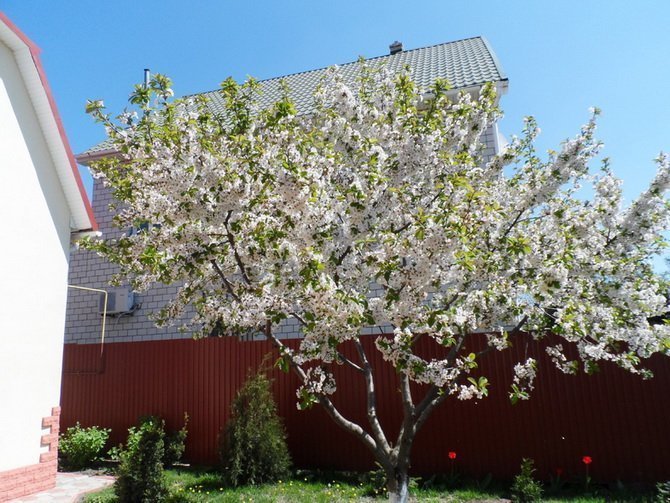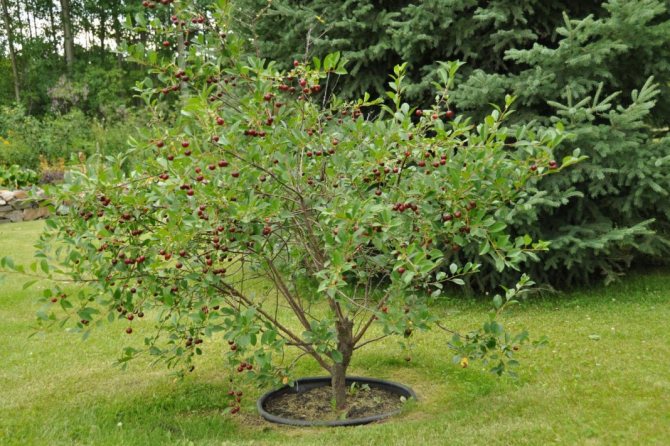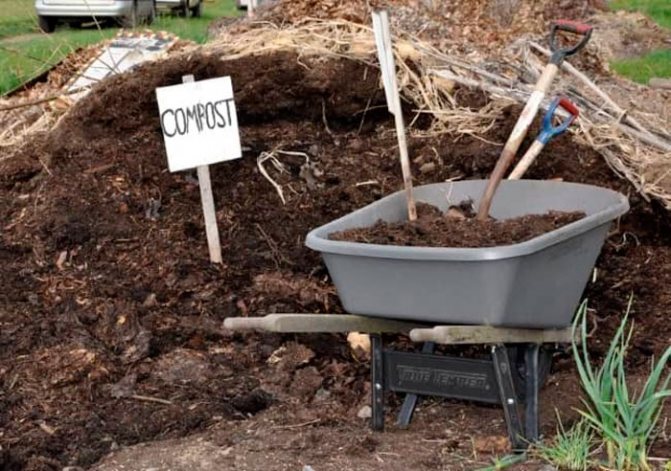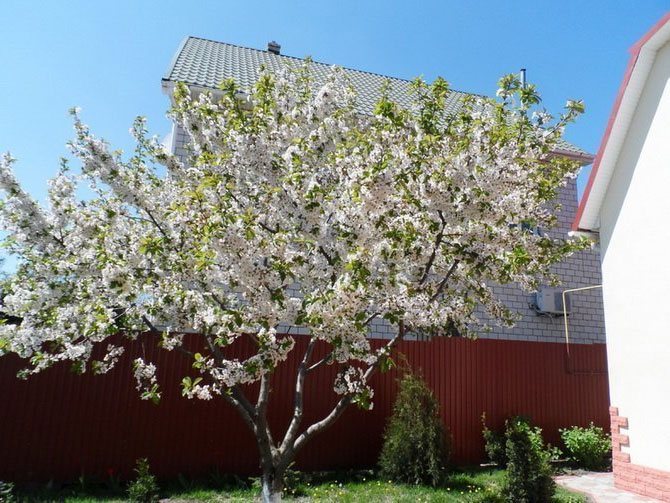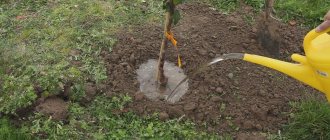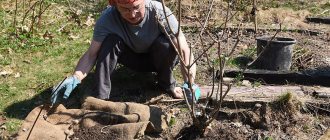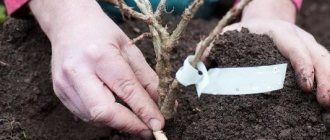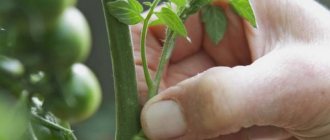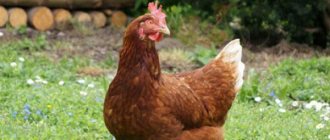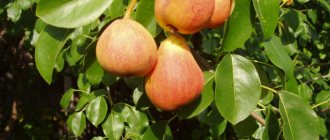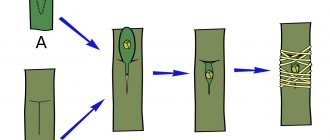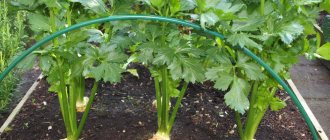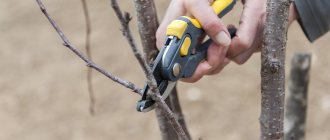Sweet cherry - a fruit tree with juicy, tasty and healthy fruits. Recently, more and more gardeners choose this particular tree instead of cherries. This is mainly due to the fact that cherries, unlike cherries, are not susceptible to serious diseases that destroy not only the harvest, but also the planting.
New varieties of cherries are even resistant to coccomycosis and moniliosis. As you know, the most favorable time of the year for planting is spring.
But many gardeners are interested in how to plant cherries in the fall?
How to plant cherries in spring
There are two options for the timing of planting cherries - spring and autumn. The first option is the most preferred and widespread, it is suitable for all growing regions. The time for planting should be chosen in early spring, when sap flow has not yet begun and the buds have not swollen. Moreover, the snow should already melt, and the earth should warm up to 5-10 ° C.
This time is good because nature begins to wake up and the planted plants will wake up with it. They will immediately begin to take root and start growing. The survival rate of seedlings at this time is maximum. And by the fall, the cherry will finally take root in a new place, get stronger, gain strength and be able to safely survive its first winter.
In southern regions with warm winters and a long growing season, an autumn planting option is possible. In this case, the time must be chosen so that 3-4 weeks remain before the onset of cold weather, during which the seedling will have time to take root. This option has one advantage - in areas with dry and hot summers, seedlings planted in spring will have to deal with drought and heat, which is excluded during autumn planting.
A cherry transplant is an undesirable event for her. Moreover, the older the plant, the more harmful the consequences can be and the higher the risk of non-survival. This is due to the inevitable injury of the root system, as well as the loss of most of it in the event of transplanting an old tree.
Most gardeners recommend doing this in early spring, especially in cold climates. This is explained by the fact that, transplanted in the fall, the tree will not have time to take root well and will leave weakened in the winter. In places with mild winters and hot summers, it is recommended to transplant in the fall, since the plant here is more likely to dry out in the summer than freeze out in the winter. In any case, when preparing for a transplant, it is better to rely on the experience of local gardeners and specialists.
Transplanting a young sweet cherry is not much different from planting a seedling. The main difference is that in order to transplant a tree, it still needs to be properly dug out of the ground.
Sweet cherry differs from its closest relative cherry in less winter hardiness. This is a thermophilic plant. Not always the harsh climate will allow young seedlings to overwinter.
In the south of Russia, Ukraine, Moldova, there is a chance that the plants planted in the fall will take root and successfully overwinter.
What characteristics should the seedlings have:
- When buying seedlings, look at their roots. The roots should not look weak, damaged. The root system needs a powerful one.
- Cut color - milky beige. A good seedling has a pronounced main guide, this will affect the formation of the crown in the future.
- The root collar should not be damaged.
- If the seedling has leaves, remove them before planting.
Recommendations for planting seedlings in the ground:
- For planting seedlings, prepare a hole 0.6-1 m wide and 0.6-0.8 m deep.
- Divide the soil into two parts: the upper one separately, the lower one separately.
- Take the following fertilizers: 2 buckets of humus, 0.5 kg of ash, 200 g of superphosphate, 60 g of sulfuric potassium. Mix these fertilizers with a layer of top soil and pour into the hole.
- Drive a stake into the ground to tie the sapling.
- Place the seedling so that the root collar rises 5-7 cm above the ground. Spread the roots.
- Sprinkle with a layer of bottom soil to keep the seedling in place. Then pour in 1 bucket of water.
- Backfill with soil until the hole is completely filled and the seedling is strengthened.
- Tie the seedling to the stake.
- Lightly tamp the soil.
- Make a circle of about 5 cm around the seedling, and spread the soil with a roller. Then the water will be absorbed evenly.
If you plant a tree correctly, and it will take root, active growth can be observed from next spring.
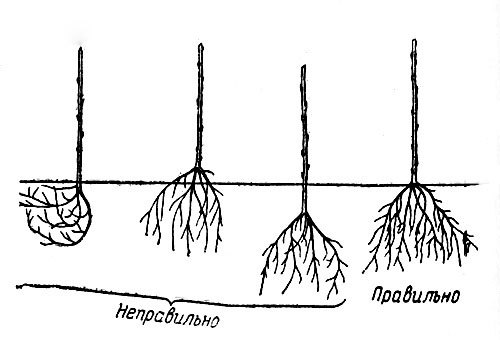
Scheme of the correct planting of cherry seedlings
Taking care of cherries in the first year is extremely important. The correct care will depend on whether the cherry will take root or not.
Wintering
It is necessary to help the tree overwinter, since the change in climate is painful for cherries.
To do this, in winter, the trunk is insulated with burlap. But if the winter is warm, you do not need to do this so that the tree does not push against it. If the winter is warm, it is enough to wrap the trunk with snow, protecting it from the wind.
In winter, rodents become more active, wanting to feast on the bark of young trees. To fight uninvited guests, pesticides are scattered around the trees.
A young tree needs regular watering. Sweet cherry loves water, but does not tolerate stagnant water. A young tree takes about 3 buckets of water. During a drought, watering young cherries is necessary once a week. If there is no drought, once a month will be enough. Watering is carried out through the hole, which is gradually expanded as the tree grows.
Top dressing
- If you apply fertilizer to the pit during planting, then no additional fertilizers, except nitrogen fertilizers, are required in the next 3 years.
- Nitrogen fertilizers stimulate vigorous tree growth. They need to be introduced in early spring or in the second year after planting. Nitrogen must not be added in autumn.
- If you did not apply any fertilizers during the planting of seedlings, you can apply organic and mineral fertilizers: humus, ash, chicken droppings, potassium, superphosphate. Fertilizers are applied with irrigation. For watering a young tree with mineral fertilizers, you should take 3 tbsp. superphosphate, 2 tbsp. l. potassium sulfate in a bucket of water.
- You can't overdo it with fertilizers. The result may be the opposite of expectations.
Spraying
Spraying is carried out in the spring in order to destroy pests that have overwintered in the soil and bark. For this, the trunks are sprayed with Bordeaux liquid.
The next spraying in summer is for insect control. For this, copper or iron vitriol, urea is used.
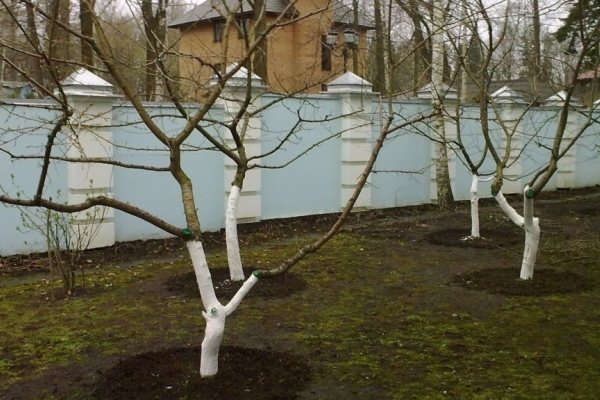

The last spraying is in the fall. Spraying is carried out with iron vitriol or Bordeaux liquid in order to prevent putrefactive diseases.
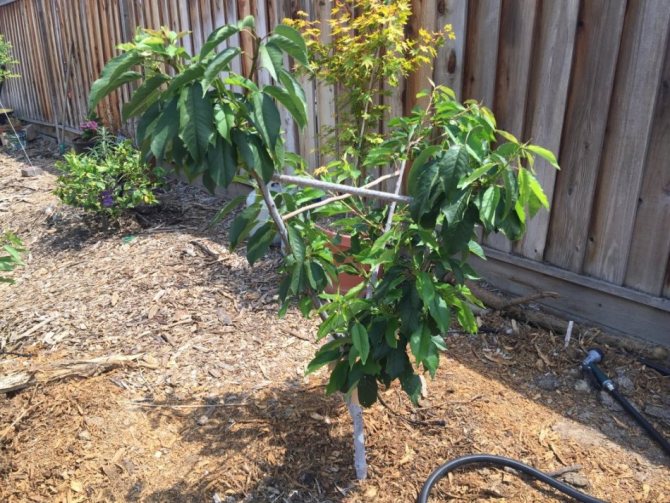

Young cherry tree
A young tree is a tasty morsel for various types of diseases, insects, birds. Spraying helps to cope with this problem, but it is important to know when and with what means to spray cherries, since pests appear at different times.
The most common spray preparations:
- Urea
- Bordeaux liquid
- Copper or iron sulfate
To spray trees, you will need a special compressor or piston pump, as well as personal protection: rubber gloves, a mask, goggles, overalls.
Below is a table from which you will learn about the timing and means for spraying.
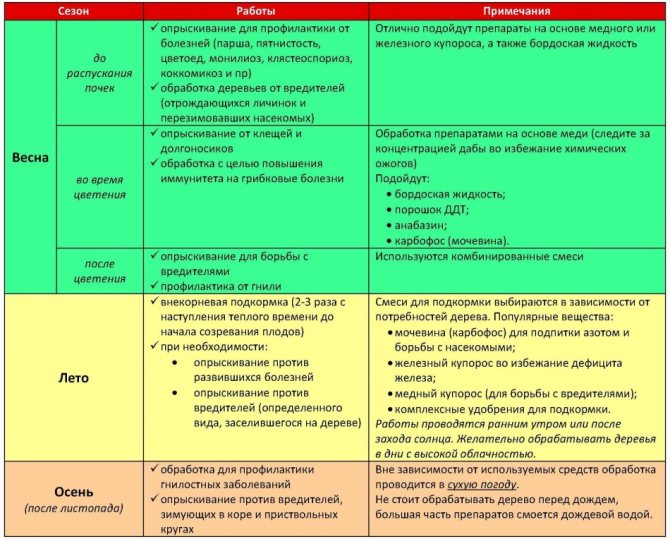

Cherry spraying table
You can feed cherries with improvised folk remedies. For this, the following means are used:
- Chicken droppings.It is introduced in the spring in a diluted form. First, pour 1.5 kg of droppings with 3-4 liters of water. This mixture should ferment for two days. Then add water up to 10 liters, mix thoroughly and water the tree.
- Crushed eggshells replace calcium, which is so essential for the growth of cherries. When digging the soil, the shell is brought in in the proportion of 2 tablespoons per 1m².
To combat cherry aphids, you can use the following folk recipe:
- Make a strong decoction of garlic, onions, or dandelions. Leave it to infuse for 2 hours.
- Add a finely grated bar of soap to a 10 liter bucket of broth.
- Spray when aphids appear on the tree.
In the spring, branches are cut in two stages:
- In March, they get rid of areas damaged in winter.
- In April, they begin to form a crown.
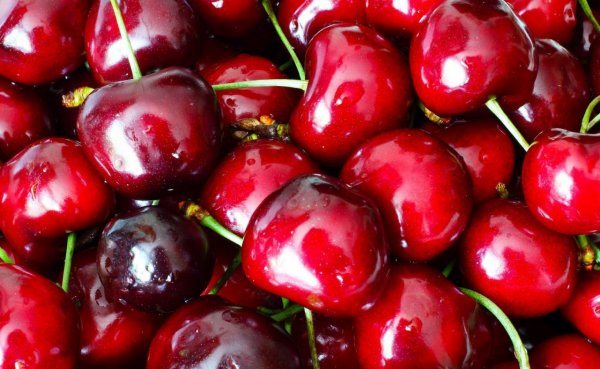

In the fall, after the leaves fall off, pruning must be done before the onset of cold weather, so that the tree has time to recover:
- First, they get rid of small, weak branches for the purpose of thinning.
- Then the shoots are shortened by a third.
In the summer, some gardeners do not touch the branches, others prefer to prune them:
- The first stage, immediately after flowering, prune the branches by pinching for horizontal growth.
- The second phase of summer pruning occurs after harvest. This time, you need to prune the branches that have grown 10 cm after the first pruning.
The formation of the crown is completed at 5-6 years of age.
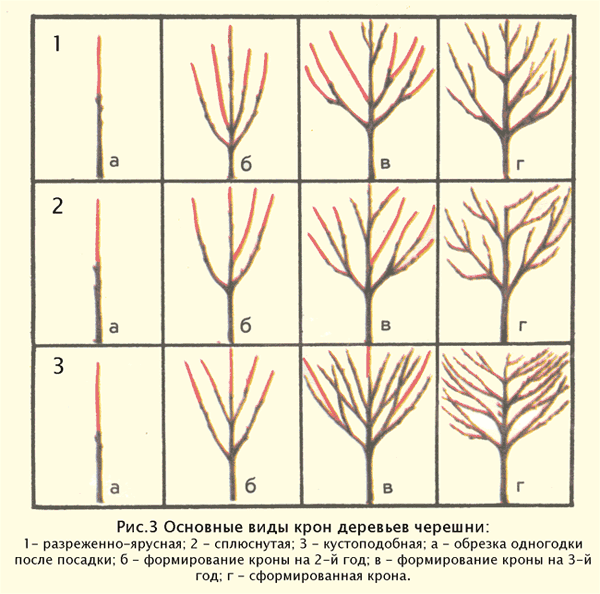

Cherry pruning scheme for 1,2,3 years
Sweet cherry blossoms when the average daily air temperature is 10-12º. The temperature should be above 15º during the day. These are the spring months of March-April.
Consider the reasons why the cherry did not bloom:
- No pollination. To do this, you need to plant not one tree on the site, but several. Cherries are not suitable for sweet cherry pollination.
- Incorrect cropping. The crown should be formed in the form of tiers or a bowl at an angle of branches of 50 *. Pruning must be done on time.
- Excess or lack of moisture. During heavy rains with stagnant water, the soil around the cherries should be mulched with a special film. Watering should not be too often once a month in the summer and in September 1 time before the onset of cold weather.
- Incorrect fit. The root collar should not be deeply planted in the ground, or vice versa - be located high. The optimum height is 5 cm above the ground.
- Pests and diseases. The tree may not bloom, as it is affected by the disease.
- Frosty winter. Cherry simply may not survive the winter if the frost resistance of the variety is low and the winter is cold.
- The time has not come. Some varieties may not bear fruit for up to 5 years.
- Wrong place. The sweet cherry may not bloom, since the planting site was chosen incorrectly.
- Feeding. If you do not apply any fertilizers, cherries may stop blooming.
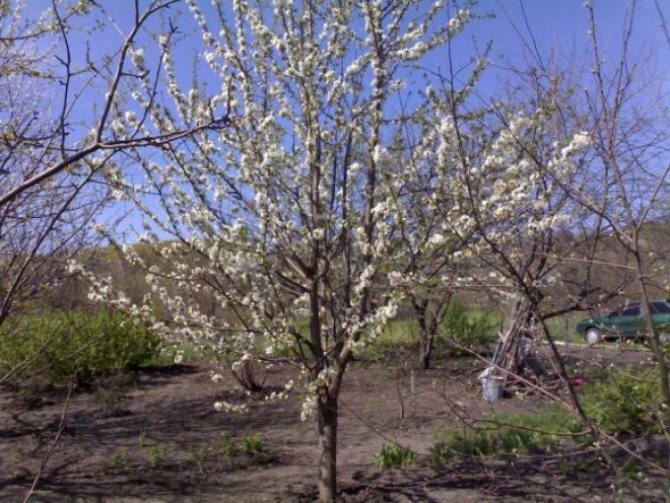

Cherry blossom
Both an old tree and a young one can freeze slightly. Young trees are most often affected after the first wintering. If the first frosts hit in the first half of winter, the tree will probably survive this phenomenon normally. The first bitter frost that appears in the middle of winter is much worse. By this time, the tree loses its frost resistance.
Preparing for winter
Most of the cherry varieties are characterized by medium frost resistance, so the young tree is carefully prepared for wintering. If extreme frosts occur, young cherries may freeze slightly.
Preparation for winter:
- Before the onset of frost, wrap the tree trunk with sackcloth - you need a "breathable" material that allows air to pass through. But if the winter turns out to be warm, the tree can stubbornly under the burlap - one must vigilantly monitor its condition.
- When the snow falls, throw it over the trunk - this will be reliable insulation for young cherries.
- To prevent damage to the bark by rodents, scatter poison near the tree. Or cover the trunk with spruce branches.
The autumn planting of cherries is practically no different from the autumn planting.It has many advantages, but they can only be used by gardeners of the southern regions - the Rostov region, the Krasnodar Territory, the North Caucasus. In harsher climates, this thermophilic crop is usually planted in the spring.
0
How to properly prepare cherries for planting?
The technology of planting cherries in autumn does not differ from the traditional spring. When planting 2-3 seedlings at the same time, it is recommended to carry out plantation plowing of the site, and then dig holes. This will help the root system of the trees to better adapt to the local soil and grow unhindered in subsequent years.
To plant cherries in the fall you will need:
- High-quality seedling from the nursery of excellent quality with a developed root system.
- Shovel, bucket, nutritious potting mix.
- Drainage material from expanded clay, crushed stone, broken brick.
- Support 80 cm long, twine or strip of fabric 2-3 m long.
The prepared pit is covered by a third with a nutrient mixture with the following composition:
- 2 buckets of excavated soil;
- 2 kg of ammonium sulfate;
- 1 bucket of humus;
- 1 kg of potassium chloride;
- 3 kg superphosphate;
- 500 g of wood ash.
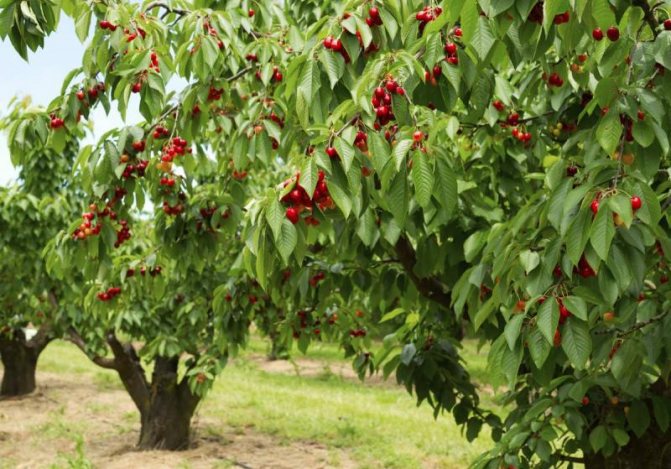

Planting is easy to handle on your own, but working in pairs is guaranteed to keep fragile roots intact.
The algorithm for planting cherries in the fall is simple:
- Organize a landing pit. The recommended hole size for young cherries is 1 m wide and 80-90 cm deep.
- Insert a support into the center of the pit for the future tree and fix it well.
- Drainage 10-30 cm thick from expanded clay or brick is laid at the bottom. In areas with clay soil, 1-2 buckets of fine river sand are poured onto the bottom of the pit.
- Pour the soil mixture into the center of the hole and form a mound.
- Carefully place the seedling so that the root collar remains above the soil surface at a height of 5-6 cm. Tie it to a support and sprinkle it.
- Pour out a bucket of warm water. Sprinkle the roots with the remaining soil, lightly tamp.
- The tree trunk is finally fixed to the support.
- The soil is compacted with high quality, but neatly.
- A trunk circle is formed, mulched with straw, hay, peat.
The more fibrous, juicy and elastic shoots the root system of a sweet cherry seedling has, the faster it will take root in a new place.
The main mistake of novice gardeners is the choice of future varieties that are not adapted to certain conditions.
This mainly applies to the northern regions. Often it is not winter itself with severe frosts that is dangerous for them, but a sharp change in air temperature in the spring season.
For planting cherries, you will need a well-lit and ventilated place. At the same time, it must be protected from cold northerly winds in the form of thick trees, walls of buildings or structures, fences. It is better to choose a small southern or southwestern slope, on which water will not stagnate. Swampiness and close occurrence of groundwater (less than 2.5 meters) are not allowed.
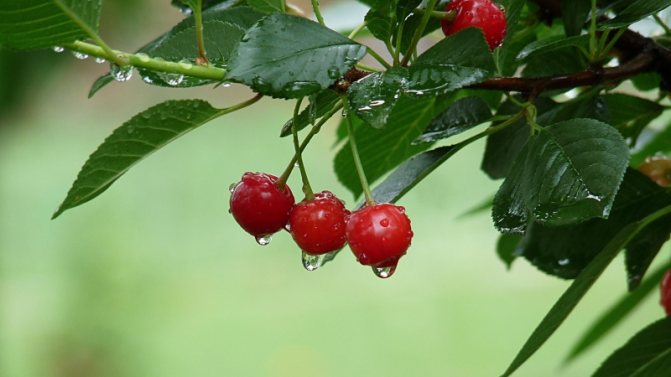

For cherries grown in arid regions, fertile loams are suitable, and in areas with sufficient or excessive moisture, sandy loam. In this case, the soil should have a loose, well-drained structure. The optimum acidity level is pH 6.7-7.1, but on chernozems with a large amount of humus, plants can also tolerate the carbonate content (increased alkaline reaction) of the soil. In this case, a reaction up to pH 8.0 is acceptable.
Planting cherries requires some preparation.
A planting pit for cherries must be prepared at least 20-30 days before planting. If it is planned for the spring, then it is better to prepare the landing pit in the fall. For this:
- You need to dig a hole 50-60 centimeters deep and 80-100 centimeters in diameter. On soils poor in humus, the volume of the pit is increased in order to introduce more nutrients into it when planting.
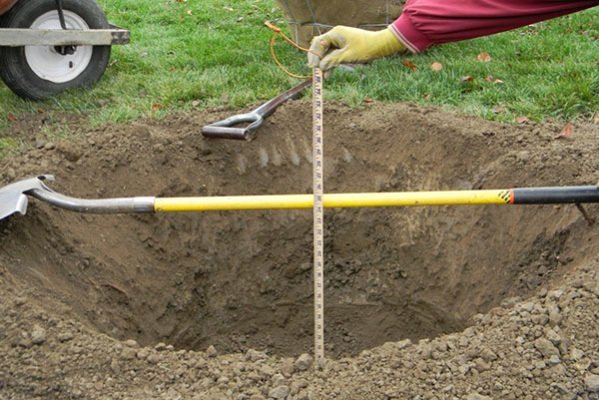

You need to dig a hole 50-60 centimeters deep and 80-100 centimeters in diameter
- If the soil is heavy, clayey, then the depth of the pit should be increased to 80 centimeters and a drainage layer 10–20 centimeters thick should be laid on the bottom of it. Crushed stone, expanded clay, gravel, broken brick, etc. are used as drainage.
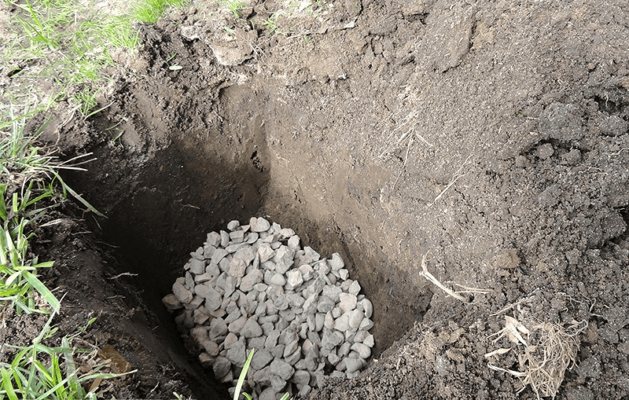

If the soil is heavy, clayey, then a drainage layer 10-20 centimeters thick should be laid on the bottom of the planting pit. - After that, the pit must be filled to the top with a nutrient mixture consisting of equal parts of black soil, peat, humus and coarse river sand. For each bucket of such a mixture add 30-40 grams of superphosphate and 0.5 liters of wood ash.
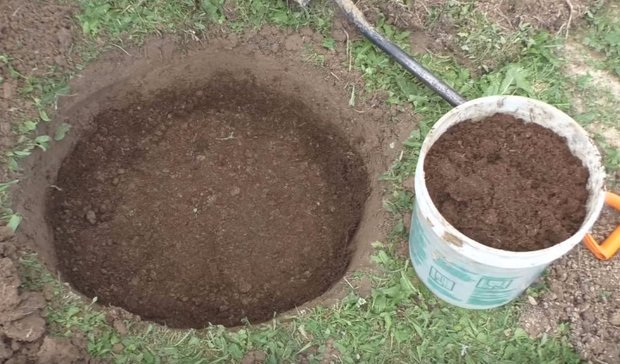

The planting hole must be filled to the brim with nutrient mixture. - For the winter, the pit is covered with moisture-proof materials (film, roofing material, slate, etc.) to prevent the washing out of nutrients by melt and rainwater.
The most common option for planting cherries is planting seedlings. They are purchased, as a rule, in the fall, since at this time there is a large selection of high-quality planting material of various varieties. It is worth giving preference to seedlings of one or two years of age. Such ones take root better and take root, they come into fruiting faster.
The root system of the seedling should be well developed and have healthy fibrous roots without outgrowths, knots and bumps. The trunk should be at least 10-15 mm in diameter, have a smooth bark without cracks or damage. Recently, cherry seedlings with a closed root system are increasingly being offered for sale. Their advantage is that such plants can be planted at any time from April to October.
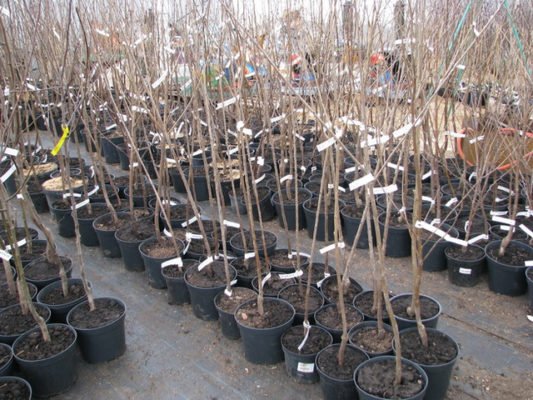

Seedlings with a closed root system can be planted at any time during the growing season
Planting cherries in the fall has its own characteristics, but the general rules for planting seedlings in open ground remain unchanged.
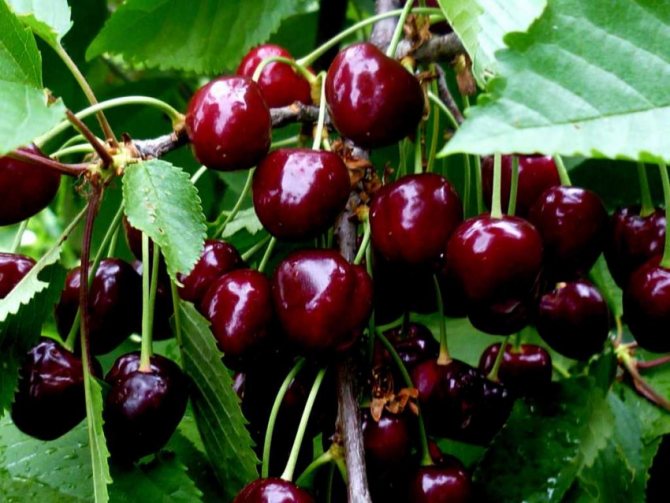

The choice of the soil in which the tree will grow will envy its fruitful characteristics. Sweet cherry is a relatively not picky tree, but some subtleties must be taken into account.
The tree does not like clay and peat soil. The plant prefers light and loose soil, rich in oxygen. The most optimal is sandstone and loam, that is, combined soils.
The acidity of the soil also plays an important role. The most suitable is neutral ground (6.7-7.1 pH).
Seedling preparation
Before directly preparing the seedling itself, you need to pay attention to the choice of a suitable young plant.
So, the important indicators of the quality of the sprout are:
- the trunk from the "scion" should be clearly visible;
- the presence of the so-called "main conductor";
- the roots must be voluminous and at least 15 cm in length;
- the optimum age for planting is a 1–2 year old plant.
After choosing a good material, it is necessary to prepare the future tree for transplantation:
- before planting, the roots must be well soaked - for this, the entire root system must be leveled (the maximum length should not exceed 15 cm), and then placed in water for 8-10 hours;
- on the branches, it is necessary to remove all the leaves, since they will take away the moisture necessary for the roots from the seedling.
Preparing the soil for direct planting of the tree is also of great importance. After choosing the seedling and the soil itself, it is time to move on to preparing the pit for planting.
Important! The seedling hole should be dug 2–3 weeks before the expected planting time.
The size of the pit depends on the size of the seedling and its root system. On average, the diameter of the pit should be 85–95 cm, and the depth should be 60–80 cm.
Moreover, the soil must be well loosened, and in the case of too "heavy" soil, it must be diluted with sand. It is recommended to add compost to the pit, as well as phosphorus and potash fertilizers (150-200 g and 40-60 g, respectively).Nutrient mixtures must be divided into two parts: one should be placed on the bottom of the pit, and the other half should be used in the process of burying the seedling.
For stability, it is necessary to drive a peg into the hole, which will correspond to at least half the length of the trunk. With this support, it will be easier for the tree to grow vertically upward, without bending to the sides.
Cherry planting technology is standard and consists of several important stages:
- Around the pre-installed support, an earthen mound with a sharp top must be made.
- A seedling is carefully placed on the top of the "mountain" so that its roots hang down on the sides. No effort is needed, the roots should be as free as possible.
- From above, it is necessary to gradually fill the earth, tightly covering the entire root system, periodically tamping the soil, and thus completely fill the hole.
- After the pit is completely filled, it is necessary to carefully compact all the ground to avoid the formation of cavities and pour 20-30 liters of warm water abundantly. The water should be exactly warm (25 ... 27 ° C), because it is at this temperature that the roots will grow as comfortably as possible into the soil and develop safely.
Planting cherries is essentially simple and not much different from planting, say, an apple tree, but there are secrets.
- Prepare planting holes in advance in a size suitable for the root system of the seedling.
- Apply fertilizers to the hole: 5 kg of humus, 50-60 g of superphosphate and 40-50 g of potassium sulfate. All fertilizers are mixed with the soil and create a slide at the bottom of the hole.
- Place the seedling on a nutritious soil mixture (hill), gently spreading the roots.
- Cover the hole with soil, compact and water.
- After watering, be sure to mulch. This technique allows you to retain moisture in the soil. As a mulch, you can use, in fact, any bulk material - sand, sawdust, peat, humus.
Planting seedlings with an open and closed root system is essentially no different with only one moment - planting seedlings with a closed root system is easier - just remove the seedling from the pot and place a clod of earth in the planting hole, that's the whole planting ._____________________________________________
Further care consists in the application of fertilizers, which is started after the trees enter fruiting, weeding, watering. Read more about leaving in this article.
Many gardeners dream of growing cherries on their site. But this tree is quite whimsical, and often the experiment on growing cherries ends in failure. If you want to enjoy the taste of cherries, you must definitely follow the requirements for planting, care, watering this tree. We will tell you about the intricacies and rules with which you can grow cherries and reap a good harvest.
Seedling care in autumn
In the year of planting, cherries do not require special care. Immediately after the first watering, the near-stem circle is mulched with any plant material, best of all spruce branches or fallen leaves of decorative trees. In the future, you will need to monitor the condition of the mulch, add a new one if necessary.
Watering a young seedling regularly, depending on the condition of the soil, once a week or less. each time up to two liters of water is poured under a young seedling. Pruning in the year of planting is not carried out. If wet snow has fallen, you can crush it off the branches so that it does not break under the weight. No more care for cherries in the fall is required.
Useful tips from gardeners
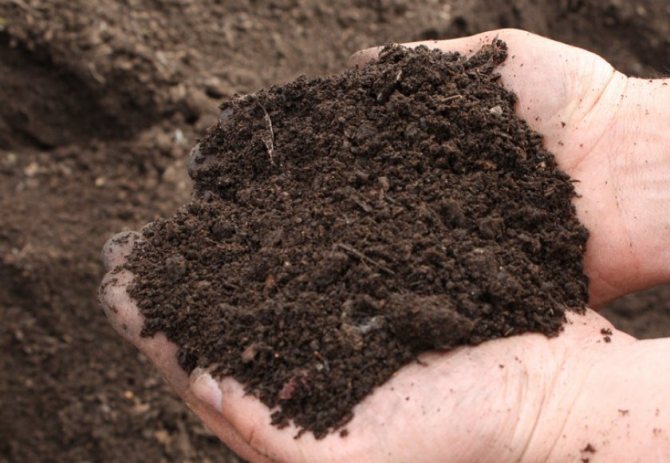

For experienced gardeners, planting cherries is common, but there are some helpful tips to help you get the best harvest and tree condition.
- Landing at this time of year is not suitable for northern regions with cold, harsh winters.
- The result directly depends on how and where to plant a plant on the site, so if there are any doubts about the variety, time and place of planting, it is better to consult a professional.
- The planting hole should not be very deep, the roots should lie freely at an angle of 45 degrees.
- For winter, cherries should be dug in and "covered" with earth, mulch, and in winter - with snow.
- It is advisable to cover the trunk with burlap.
- In winter, it is necessary to scatter mouse poison around the tree, since in winter mice can damage a young, fragile trunk.
So, planting seedlings in the autumn period is more optimal than the spring one, since during the fall and winter the plant will have time to form a strong root system. This process has its own important, but not complicated features, and, following all the useful advice, the summer resident will be able to achieve an abundant tasty harvest and a beautiful healthy tree in his favorite area.
Pick a place
It is allowed to plant plants near dwellings, natural barriers in the form of dense shrubs or trees with a wide crown, but they should not create a shadow.
Sweet cherry prefers well-lit soils, preferably with a southern orientation. Fertile and sufficiently moisture-rich soils are suitable, it is great if they are well-drained, sandy loam or sod-podzolic.
The groundwater level must be at least 2.5-3 m from the soil surface. Acidity is also important - ideally if the pH is 6-6.5.
For planting cherries are NOT suitable:
- Clay soils, especially those with a heavy texture.
- Peat bogs.
- Sandy soils (even fertilization will not help, which can only lead to a decrease in winter hardiness).
- Soils with frequent stagnation of moisture (after rains, in the spring after snow melt).
The most suitable time for autumn planting of sweet cherries is considered to be early autumn - September is best, closer to its end.
- Closed root seedlings (CCS) can be planted from September to the end of October.
- It is undesirable to plant seedlings with an open root system (ACS) even in October, it is better to limit ourselves to September, all the same, the nature of the culture is southern.
When is it better to plant cherries: in spring or in autumn?
Sweet cherry is a southern culture. Therefore, in the conditions of cold autumn and harsh winter, it is better to plant cherries in early spring. In the southern regions, with a warm mild climate, both autumn and spring planting is allowed.
More often two-year-olds are planted according to the 5x3 m scheme: 5 m - between rows, and 3 m - between plants in a row.
To guarantee a stable harvest on the site, you must have at least a couple of different varieties, but always blooming at the same time.
Choosing the right place
The place is chosen carefully so that the plant takes root without problems. The best option is a hill, where there is a lot of sunlight and no shading. The sun should illuminate the plant all day, as a last resort, enough lighting in the morning.
Soil requirements:
- The presence of a fertile layer is desirable.
- Light soil character.
- With a weak fertile layer, humus or compost is placed in the pit.
- Away from groundwater and marshy areas to avoid waterlogging.
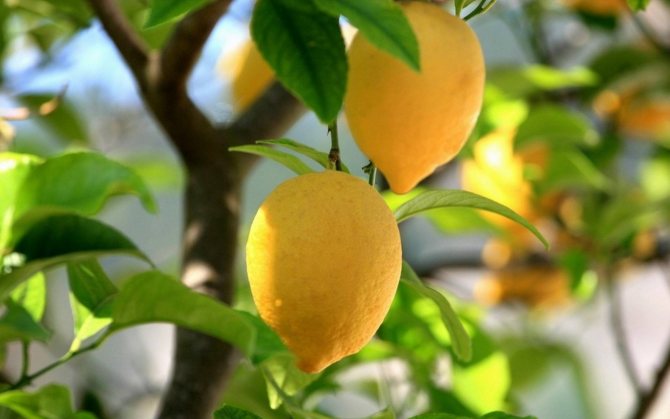

The seedling will need top dressing at the initial stage of development in order to obtain the substances necessary for growth. Excessive soil moisture can lead to root rot. Because of this, cherries are not recommended to be planted in lowlands.
The seedlings must be protected from the cold north wind. Strong winds can cause irreparable damage to the shoots. Young plantings will not get stronger immediately, so deformation for them can be fatal. The wind blows snow from the near-trunk space, which deprives the root system of frost protection.
How an avocado tree grows and looks in the wild
The absence of natural barriers is compensated by homemade ones. To do this, put fences or lay hay around the perimeter, around the seedlings. The efficiency will be lower, but the wind will still reduce its strength.
How to germinate cherries from the seed: a step-by-step guide
You can grow cherries from a stone for the sake of experiment. Many people like the very process of such growth and the final result of their experience, for the sake of sports interest. You will be surprised, but there is a benefit in raising wild game.
Wildlife is ideal for grafting good varieties of cherries. Demanding cherries are susceptible to diseases, depend on the temperature difference, and the wild is unpretentious, grows well and can become a real assistant in the formation of an orchard.
- The choice of material.
- Preparation of material for planting.
- Planting sprouts in pots.
- Planting sprouts in the soil.
Let's take a look at what these steps involve.
Material selection
The cherries that you bought on the market are not suitable for growing from stone. The fact is that unripe berries are plucked for implementation, the embryo in the seed is not fully formed. Choose only ripe cherries from the tree, you can take fallen fruits. Check that there are no chips on the underwire. If you have collected fruits from different varieties of cherries, sort the seeds into different containers.
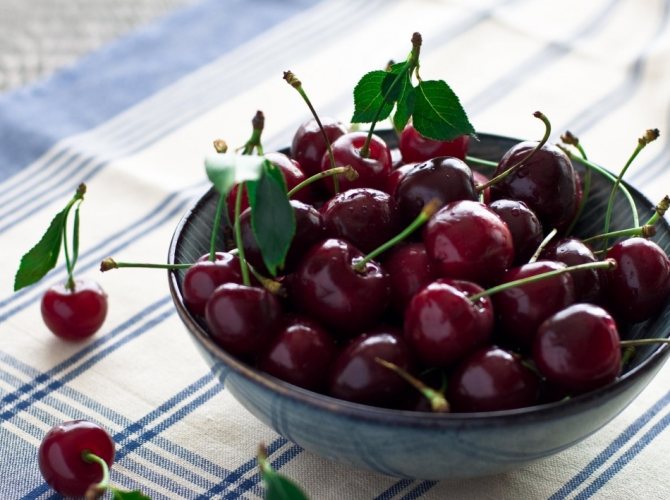

Ripe selected cherries
Preparing material for planting
- Dry all collected bones. Then wrap them in paper, wrap them with plastic on top. In this form, the seeds should be stored until the end of November in a cool place.
- At the end of November, place the seeds in water for no longer than 3 days.
- After 3 days, place the seeds in wet sand, cover the container with foil and place in a cool place with a temperature not exceeding 2 °.
- Water and air the planting material every day.
- It remains to wait for the sprouts to appear.
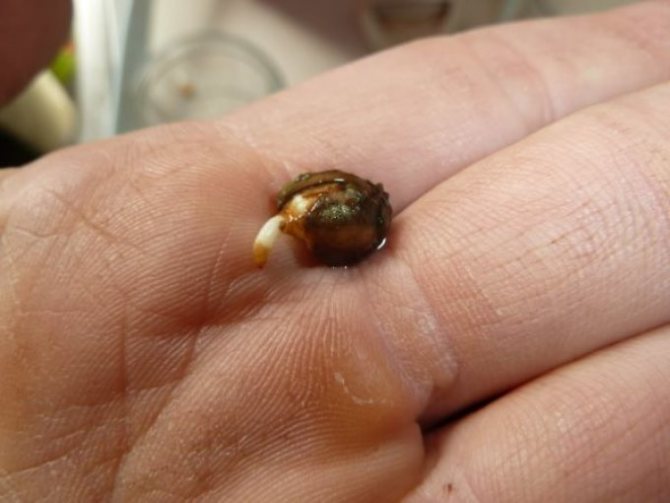

Sprouted cherry pits
Planting sprouts in pots
Recommendations for planting sprouts:
- It is advisable to buy the soil in the store. It contains all the necessary additives for the growth of a tree.
- If you take soil from the garden, you need to heat it. For example, in the microwave or in a water bath.
- A drainage layer (crushed stone, fragments of clay products, expanded clay) should be placed on the bottom of the container.
- Add charcoal to the soil to loosen the soil.
- Plant the seeds in moist soil to a depth of 2 cm.
- Cover the container with plastic wrap and place in a well-lit place without drafts.
- Ventilate the sprouts every day, keep the soil moist, but do not overfill.
Planting shoots in open soil occurs in the spring, when the snow has completely melted, before buds appear on the trees.
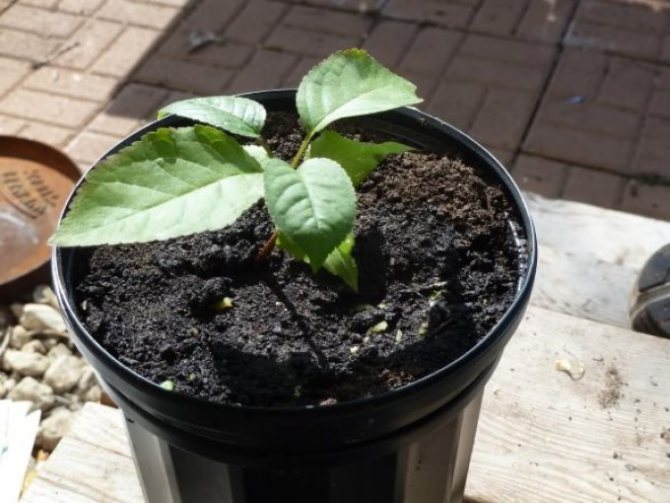

How cherry grows from a stone
Simple rules for proper cultivation
In northern regions, it is not recommended to use autumn planting.because it is more likely that young trees will not be able to survive the harsh winter climate and will simply die.
Therefore, the seedlings bought in the fall can be dug into the ground before the onset of spring. For such a procedure, you need to dig a shallow hole into which the roots of the tree will fall at an angle of 45 degrees.
When purchasing several seedlings at once, they are tied together. When digging them into the ground, you need to make sure that the top is directed to the south side.
With the onset of cold weather, the tree must be protected from their negative influence. The branches are covered with earth and snow, they will be reliable protection against freezing. Also, to avoid sunburn, cherries are covered with plywood.
In which direction to plant cherries by grafting?
It is advisable to plant in the spring. Then the young tree will have time to get stronger, the root system will grow, and he will be able to gradually prepare for frost.
When planting a tree, it is recommended to look at the climatic conditions of the region. If the temperature is less than 5 degrees above zero, then it is unlikely to be accepted.
When planting cherries in spring, more positive aspects can be noted than at other times of the year. But in order to determine what is best for yourself, you should familiarize yourself with everything in advance.
- A young tree can grow stronger in only six months and give shoots. This will help him to settle down and overwinter the frost in the region;
- During this time, the gardener can carefully monitor the seedling, during watering, and also protect the plant from parasites and various diseases;
As with many plants, there are a number of negative aspects here. Since many plants go through the growing season in the spring season, the seedling will need strength not only to recover, but also to grow foliage.
Also, many gardeners during this period are very busy, and they have very little time to give the required attention to all young trees.
In which direction the vaccine will look does not matter. The important thing is where you plant the cherry seedling.
Sweet cherries need cross-pollination. Therefore, it is recommended to plant 2-3 trees at once so that they pollinate each other.
Therefore, even at the moment of laying the garden, you should take care of the correct distance. It depends on the dimensions of an adult tree and is calculated using the formula: A1 A2 (m). Where A1 and A2 are the maximum tree height.
If it is not possible to calculate the height of the trees or there is no place in the garden, the average distance between trees should not be less than 3-5 m.
Cherry diseases and pests: description with photos and control measures
Dangerous pests of sweet cherries:
- Cherry fly. It becomes more active in May. First, it feeds on the juice of the leaves, and then begins to lay eggs on the fruits of the sweet cherry. Over time, the larva makes its way into the pulp and eats it. The fruit becomes soft and falls off the tree. There are white worms inside the fruit. To combat this pest, in the fall, they dig up the soil around the trunk, and in the spring, before flowering, they are sprayed with insecticides.
- Aphid. Damages tree leaves and shoots. You can suspect the presence of aphids by twisted leaves and twisted shoots. You need to fight aphids in 2 stages: in the spring, before the buds swell and after the buds open. For the first time, trees are treated with nitrophen, and then metaphos, karbofos.
- Cherry slimy sawfly. An insect that feeds on the leaves of trees. The larvae of a greenish-yellow color after fattening go under the bark and may not leave there for 2-3 years in case of drought. You can fight this insect with chlorophos, karbofos, cyanox, etc.
- Cherry pipe wrench. A dark green beetle up to 1 cm in size. It feeds on bark, leaves, fruits and even cherry seeds. The female lays her larvae in the pulp. Control methods: spraying with actellik, gardona, karbofos after tree flowering.
- Brown fruit mite. It affects cherries, leaving larvae skins on the bark. A sign of damage by a fruit mite is a silvery tree tint. You need to fight the tick in several approaches with different types of acaricides: colloidal sulfur, metaphos, zolone. A tick of this species quickly becomes addicted to the drug.
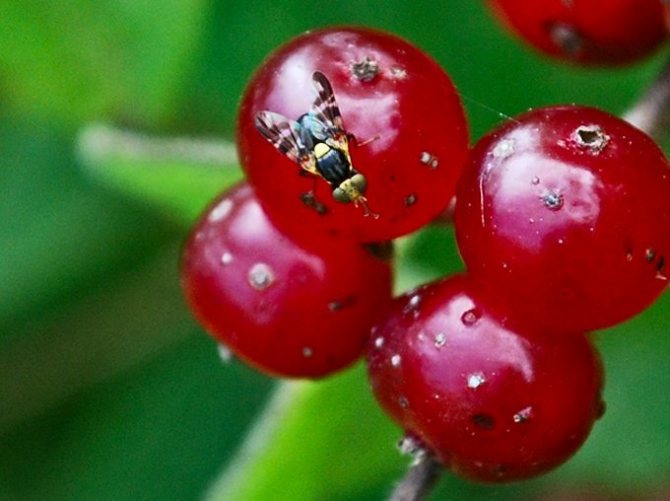

Cherry pests: cherry fly
The most dangerous diseases of sweet cherry:
- Coccomycosis. Small brown dots form on the leaves, which subsequently grow. The disease destroys the fruit, the tree. Prevention of coccomycosis - treatment of trees with copper sulfate and Bordeaux liquid.
- Sweet cherry rot (brown, brown, fruit rot). Formed as a result of damage to the skin of the fetus. Insects and pests often destroy the integrity of the skin, resulting in rot on the cherries. Rot can be prevented by preventing insects from infesting the tree.
- False tinder fungus. Causes wood rot from the inside. As a result, the tree becomes weak, sick. Control methods: disinfection of tree wounds with garden varnish and treatment with copper sulfate, whitewashing of the trunk with lime, increasing the frost resistance of trees.
- Moniliosis. A fungal disease of a tree that can destroy an entire garden. Outwardly, the trees look dry - shoots, leaves, buds dry and turn brown. If you notice such a disease in your tree, cut off the diseased branches, then burn the diseased branches. Disinfect the sections. Copper-based preparations are also used.
- Clusterosporosis.The main symptom is that the leaves become perforated. Methods of dealing with this disease, as in coccomycosis.
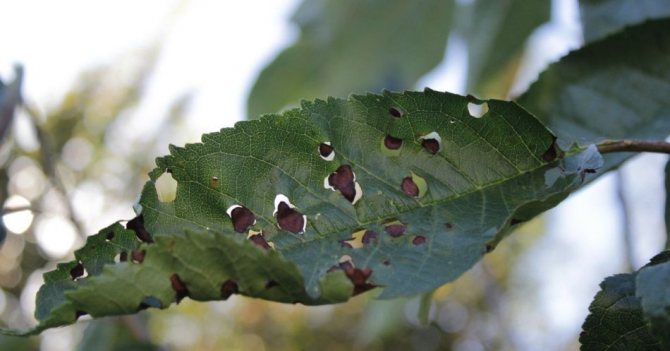

Cherry diseases: clusterosporosis

